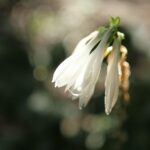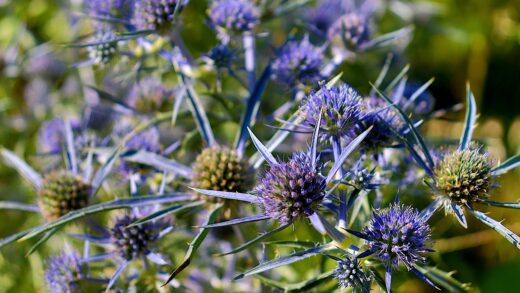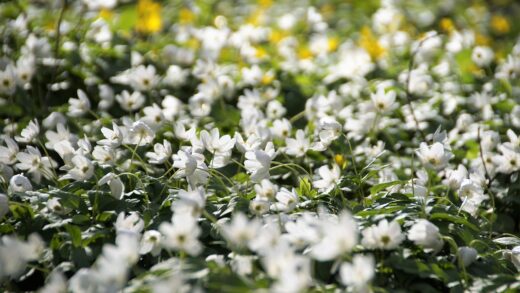While generally robust and resilient when provided with the proper growing conditions, Japanese maples are not entirely immune to the challenges posed by diseases and pests. A stressed or weakened tree is far more susceptible to attack, which underscores the importance of proactive care in maintaining its defenses. Recognizing the early signs of trouble, from subtle changes in leaf color to the presence of tiny insects, allows for timely intervention that can prevent minor issues from escalating into serious threats. A vigilant gardener who understands the common ailments that can affect these trees is well-equipped to protect their beauty and ensure their long-term health. This knowledge transforms a gardener from a mere cultivator into a capable steward of the tree’s well-being.
Common fungal diseases
One of the most serious diseases that can affect Japanese maples is Verticillium wilt, a fungal pathogen that lives in the soil. The fungus enters the tree through the roots and spreads upwards through the xylem, the tree’s water-conducting tissues. This clogs the vascular system, preventing water from reaching the branches and leaves, causing a sudden wilting and dieback of one or more branches, often on just one side of the tree. The leaves on affected branches will turn yellow or brown and drop prematurely. A key diagnostic sign is a dark, olive-green streaking that can sometimes be seen in the sapwood just beneath the bark of an infected branch. Unfortunately, there is no chemical cure for Verticillium wilt.
Anthracnose is another common fungal disease, particularly prevalent during cool, wet spring weather. It typically appears as irregular-shaped tan, brown, or black spots or blotches on the leaves. In severe infections, the spots can merge, causing large dead areas, leaf distortion, and premature leaf drop. While it can be visually alarming, anthracnose is rarely fatal to an otherwise healthy and well-established tree. The best management strategy involves improving air circulation through proper pruning, avoiding overhead watering that keeps the foliage wet, and raking up and destroying infected fallen leaves in the autumn to reduce the amount of fungal spores that can overwinter.
Powdery mildew is a fungal disease that is easy to identify, appearing as a white or grayish powdery coating on the surface of the leaves and new shoots. It thrives in conditions of high humidity, particularly on warm days followed by cool nights, and is more common on trees planted in shady locations with poor air circulation. While it is unsightly, powdery mildew typically causes only cosmetic damage and does not seriously harm the long-term health of the tree. Management includes pruning to improve airflow, and in persistent cases, applications of horticultural oil or a fungicide specifically labeled for powdery mildew can be effective.
Phyllosticta leaf spot is another fungal issue that causes small, circular spots on the leaves, which often have a purple or brown border and a tan or gray center. As the disease progresses, the center of the spot may fall out, giving the leaf a “shot-hole” appearance. Similar to anthracnose, this disease is most active during wet spring weather and is generally not a major threat to the tree’s overall health. Good sanitation, such as cleaning up fallen leaves, and improving air circulation are the primary methods of control. Fungicide treatments are usually not necessary for this particular leaf spot disease.
More articles on this topic
Pests that target japanese maples
Aphids are one of the most common insect pests found on Japanese maples. These small, pear-shaped insects often cluster on the undersides of leaves and on tender new shoots, using their piercing mouthparts to suck sap from the plant. A heavy infestation can cause leaves to curl, yellow, and become distorted. As they feed, aphids excrete a sticky substance called honeydew, which can coat the leaves below and lead to the growth of sooty mold, a black fungus that, while not directly harmful, can interfere with photosynthesis. Aphids can often be controlled by a strong spray of water from a hose to dislodge them or by introducing beneficial insects like ladybugs and lacewings that prey on them.
Scale insects are another type of sap-sucking pest that can be more difficult to control. These insects look less like typical bugs and more like small, immobile bumps or shells attached to the stems and branches of the tree. They protect themselves under a waxy or armored coating, which makes them resistant to many contact insecticides. Scale insects also produce honeydew, leading to sooty mold. A key control method is to apply dormant horticultural oil in the late winter or early spring, before the leaves emerge. This oil smothers the overwintering insects and their eggs. During the growing season, a systemic insecticide may be needed for severe infestations.
The Japanese beetle, as its name might suggest, can be a significant pest for Japanese maples in areas where it is prevalent. The adult beetles are voracious feeders and can skeletonize the leaves, eating the tissue between the veins and leaving behind a lace-like remnant. They are most active in mid-summer. Controlling Japanese beetles can be challenging. Hand-picking the beetles and dropping them into a bucket of soapy water is effective for small trees or light infestations. Pheromone traps are widely sold but can sometimes attract more beetles to your garden than they capture. In cases of severe defoliation, chemical insecticides may be necessary.
Mites, particularly spider mites, can also be problematic, especially in hot, dry conditions. These tiny arachnids are difficult to see with the naked eye, but their damage is visible as a fine stippling or speckling on the leaves, which may also take on a bronze or dusty appearance. In heavy infestations, you may see fine webbing on the undersides of leaves and along the stems. Mites thrive in dry environments, so one of the best preventative measures is to ensure the tree is well-watered and to occasionally hose down the foliage to increase humidity and dislodge the pests. Insecticidal soaps or miticides can be used for control if the population becomes too large.
More articles on this topic
Understanding root and bark issues
Root rot is not caused by a pest or a specific disease but is rather a physiological condition resulting from poorly drained, waterlogged soil. When the roots are deprived of oxygen, they begin to die and decay, making them vulnerable to secondary infection by various soil-borne water molds and fungi. The symptoms of root rot appear in the canopy as wilting, yellowing leaves, and branch dieback, often mimicking the signs of drought. The only solution is to address the underlying drainage problem. For a tree in the ground, this may involve re-grading the area or installing a French drain. For a container plant, it means repotting into a better-draining medium and ensuring the pot has adequate drainage holes.
Sooty mold, as mentioned earlier, is a direct consequence of a sap-sucking insect infestation. The mold itself does not feed on the tree but on the sugary honeydew excreted by pests like aphids and scale. It appears as a black, soot-like coating on leaves, stems, and anything else beneath the infested branches. While it does not infect the tree, a thick layer of sooty mold can block sunlight and interfere with photosynthesis, potentially reducing the tree’s vigor. The key to controlling sooty mold is to control the insect pest that is producing the honeydew. Once the insects are gone, the sooty mold will eventually weather away.
Lichen and moss are often found growing on the bark of mature Japanese maples, particularly in humid climates. Many gardeners worry that these growths are harming their tree, but it is important to understand that they are completely harmless. Lichens and moss are epiphytes, meaning they simply use the tree’s bark as a surface to grow on; they do not penetrate the bark or draw any nutrients or water from the tree. In fact, their presence is often an indicator of good air quality. There is no need to remove them, as any attempt to scrape them off could damage the delicate bark of the maple.
Sunscald and frost cracks are forms of bark damage caused by environmental factors. Sunscald occurs in winter when the sun warms the southern or southwestern side of a young tree’s trunk during the day, causing the cells to become active. When the sun sets or goes behind a cloud, the temperature drops rapidly, killing these active cells and causing the bark to split and peel. Frost cracks are similar vertical splits that occur due to rapid temperature fluctuations. Both issues can be prevented on young, vulnerable trees by wrapping the trunk with a commercial tree wrap or a light-colored paper for the winter months. This reflects the sunlight and moderates the bark temperature.
Prevention as the best medicine
The most effective strategy for dealing with pests and diseases is to prevent them from becoming a problem in the first place. This begins with providing the tree with its ideal growing conditions. A healthy, vigorous tree growing in the right location with the proper soil and moisture levels is naturally more resistant to stress and better able to fend off attacks from pests and pathogens. Stress from factors like drought, overwatering, soil compaction, or too much direct sun can weaken a tree’s defenses and make it an easy target.
Good garden sanitation, or hygiene, plays a crucial role in disease prevention. Fungal spores and insect eggs can overwinter on fallen leaves and debris around the base of the tree. Raking up and disposing of this material in the autumn, especially if the tree showed signs of disease during the growing season, can significantly reduce the inoculum available to cause new infections the following spring. Similarly, pruning out any dead, damaged, or diseased branches as soon as you notice them can stop the spread of a problem and remove potential entry points for pests.
Promoting good air circulation around and through the canopy of the tree is another key preventative measure, particularly for fungal diseases that thrive in moist, stagnant air. This can be achieved through proper site selection, ensuring the tree is not crowded by other plants or structures. Strategic pruning to thin out dense areas of the canopy can also improve airflow. When you water, use a soaker hose or drip irrigation to apply water directly to the soil, avoiding overhead sprinklers that wet the foliage and create a favorable environment for fungal growth.
Finally, regularly inspecting your tree allows you to catch problems early. Make a habit of walking through your garden and looking closely at your plants. Check the undersides of leaves for insects, look for any unusual spots or discoloration, and take note of the tree’s overall posture and vigor. Early detection makes control much easier and more effective. A small aphid colony can be washed off with a spray of water, but a full-blown infestation may require chemical intervention. By being a vigilant and observant gardener, you can act as your tree’s first line of defense.
Integrated pest management (IPM)
Integrated Pest Management, or IPM, is a holistic and environmentally sensitive approach to managing pests and diseases. It does not seek to eliminate pests entirely but to keep their populations below a level where they cause significant damage. IPM prioritizes the least toxic control methods first, only resorting to chemical pesticides when absolutely necessary. The first step in an IPM program is always proper identification; you cannot effectively control a problem until you know exactly what pest or disease you are dealing with.
Cultural controls form the foundation of IPM. These are the preventative practices discussed earlier: selecting the right plant for the right place, maintaining healthy soil, providing proper irrigation, and practicing good garden sanitation. These actions create a strong, resilient plant and an environment that is less hospitable to pests and diseases. For example, ensuring good drainage is a cultural control for root rot, and thinning the canopy to improve airflow is a cultural control for powdery mildew.
Biological control is the next step, which involves using a pest’s natural enemies to keep its population in check. You can encourage the presence of beneficial insects like ladybugs, lacewings, and predatory wasps in your garden by planting a diversity of flowering plants that provide them with nectar and pollen. In some cases, you can even purchase and release these beneficial insects. This approach creates a balanced ecosystem where pest populations are naturally regulated.
When cultural and biological controls are not sufficient, you may need to move on to physical or mechanical controls. This can be as simple as hand-picking Japanese beetles off the leaves or using a strong jet of water to dislodge aphids. Setting traps can also be a form of mechanical control. If the problem persists, the next level involves using low-impact chemical controls, such as horticultural oils, insecticidal soaps, or products derived from natural sources like neem oil. These are generally less harmful to beneficial insects and the wider environment than broad-spectrum synthetic pesticides, which should always be the last resort.


















